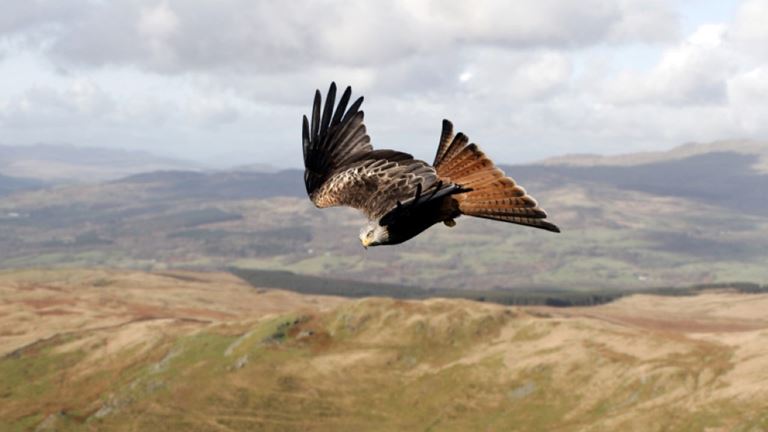
Red Kites were alive and well in the 1800s in the Lake District. I have found three separate references to kites in the poems of William Wordsworth and one mention by his sister, Dorothy. There may be more references than these but they alone prove that the iconic birds were a common sight in the Lake District just over two hundred years ago.
The first two instances are from Wordsworth’s narrative poem, Michael and from Dorothy’s Journal, dated 11 Oct 1800.
Greenhead Gill, mentioned at the beginning of Michael is a mountain stream/ravine behind the Swan Hotel, which is north of Grasmere.
If from the public way you turn your steps
Up the tumultuous brook of Greenhead Ghyll,
You will suppose that with an upright path
Your feet must struggle; in such bold ascent
The pastoral mountains front you, face to face.
But, courage! for around that boisterous brook
The mountains have all opened out themselves,
And made a hidden valley of their own.
No habitation can be seen; but they
Who journey thither find themselves alone
With a few sheep, with rocks and stones, and kites
That overhead are sailing in the sky.
As was usual with Wordsworth, some of his lines were prompted by his sister Dorothy. It seems Wordsworth was writing the early drafts of Michael in Oct 1800. She writes in her journal:
After dinner we walked up Greenhead Gill in search of a sheepfold. . . The colours of the mountains soft, and rich with orange fern; the cattle pasturing upon the hill-tops; kites sailing in the sky above our heads. Sheep bleating and in lines and chains and patterns scattered over the mountains.
The third reference is from the autobiographical The Prelude, Book First:
The heart is almost mine with which I felt,
From some hill-top on sunny afternoons,
The kite high among the fleecy clouds
Pull at her rein like an impetuous courser,
*
The fourth from his long poem, The Excursion:
With care and sorrow; shoals of artisans
From ill-requited labour turned adrift
Sought daily bread from public charity,
They and their wives and children – happier far
Could they have lived as do the little birds
That peck along the hedgerows, or the kite
That makes her dwelling on the mountain rocks!
In many of Wordsworth’s poems place-names are mentioned so it is possible to walk in his footsteps. When my parents were alive they lived at Troutbeck Bridge and I would often set off from there to walk behind Rydal Mount (one of Wordsworth’s residences) in the White Moss area. Easedale Tarn, accessible from Grasmere village, was another favourite, and nearby Helm Crag with its famous ‘Lion and the Lamb’ rock.
A mere decade or two after Wordsworth’s sightings, Red Kites began to be persecuted by Gamekeepers and by the closing decades of the nineteenth century they were extinct in England and Scotland. In the 1990s reintroduction programmes were established in England and Scotland. Our North East birds came as chicks from the Chilterns. They were released in the Derwent Valley in Gateshead in a four year project. There is a link in my blogroll to Friends of Red Kites.
I have been in touch with a curator-trainee at Dove Cottage (Wordsworth’s residence at Grasmere) and she tells me kites have been seen recently soaring overhead, so that is good news!
interesting article. did your parents move to cumbria after retiring from work in Bradford? john—— Original Message ——
LikeLike
They retired from work in Scotland.
LikeLike
I’ve just finished Hunter Davies’ excellent biog of Wordsworth and he says Easedale was his favourite walk. It is an very accessible walk from Grasmere and I remember buying some walking boots in Ambleside and trying them out by walking up to Easedale Tarn. I’ve done the walk many times without knowing it was Wordsworth’s favourite.
LikeLike
This was an interesting article! I just thought you might be interested about an alternative interpretation of the reference to the kite in The Prelude — although the part you quoted is often believed to refer to a red kite, in fact in the first edition of the poem it was clearly referring to a paper kite:
“—Unfading recollections! at this hour
The heart is almost mine with which I felt,
From some hill-top on sunny afternoons,
The paper kite high among fleecy clouds
Pull at her rein like an impetuous courser;
Or, from the meadows sent on gusty days,
Beheld her breast the wind, then suddenly
Dashed headlong, and rejected by the storm.”
The mention of “paper” was removed in later editions of the poem — whether Wordsworth still intended the lines to refer to a paper kite or rather the bird is unclear, although personally I think the references to being “dashed headlong” and “rejected by the storm” would seem to refer to a paper kite which falls to the ground without the right wind. Hope you found this interesting (I actually wrote about this in my dissertation, connecting it to Seamus Heaney’s kite poems which i would really recommend if you haven’t read them already!)
LikeLike
That’s interesting Rachel.Looking at early drafts can result in discoveries!
LikeLike